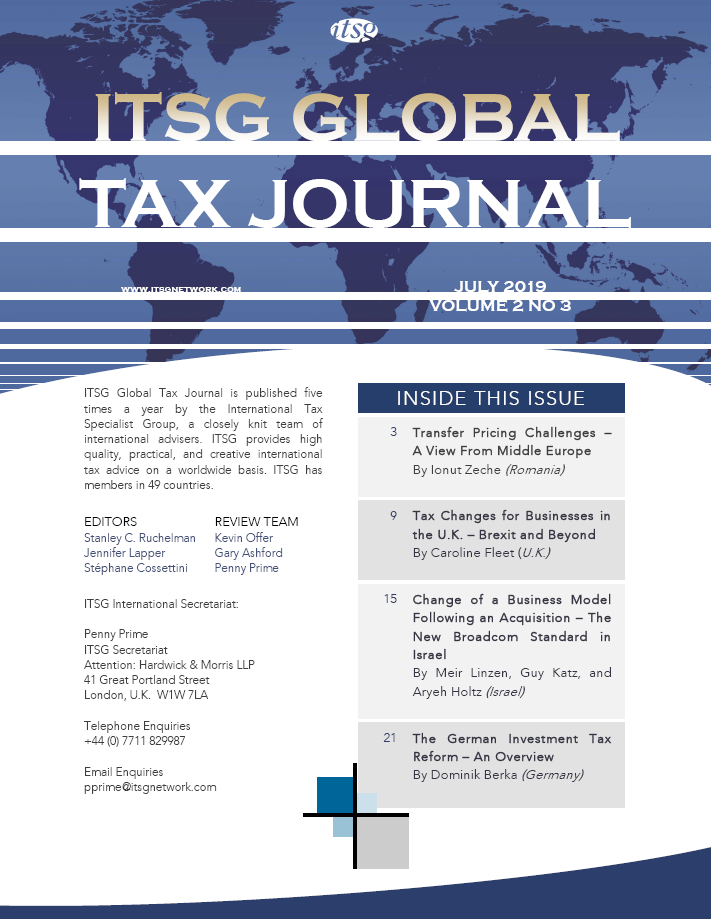The issue of transfer pricing has been gaining international traction since the 1970’s when, with the growing globalisation of trade, multinational enterprises developed their activities and transactions between affiliated companies in other countries. In Romania, the issue of transfer pricing became a hot topic when government officials estimated multinational enterprises were transferring as much as €1 billion in profits to other countries or regions, allegedly avoiding taxation in Romania.
Bypassing the political and electoral layers of such statements, it is quite clear that the N.A.F.A. (National Agency of Fiscal Administration) identified that, in the transfer pricing area, a significant proportion of the state budget was being moved to other jurisdictions. To counter this, tax authorities triggered a series of audits and, by 2018, many of the large taxpayers encountered inspections focused on transfer pricing. In the face of this avalanche of audits, multinational enterprises were only able to respond in one way: by presenting a properly prepared transfer pricing file.
O.E.C.D. transfer pricing guidelines
Even though the issue of transfer pricing surfaced more than one-half a century ago in certain countries, the 2008-2009 financial crisis pushed states into taking a number of measures and performing risk analyses to assess what was happening with corporate profits not matched by corporate taxation. The need for cash forced developed countries to look for other areas from which funds could be raised for the state budget. For example, the U.S. government conducted an analysis to see how much taxes on American companies contributed to the Federal budget. When it was reported that these companies were not paying commensurate with the published corporate tax rate, American authorities wanted to see where that money was going.
Although it began in the U.S., the issue of transfer pricing has since expanded. What is happening today in Romania is in line with the approach of tax authorities in most European countries. Currently, we are neither ahead of nor behind the trend, but it is clear that the Romanian authorities want to follow the beaten path and maybe even surpass Western countries. Why? Because there is potential to attract revenues for the state budget.
From a legal point of view, transfer pricing has been regulated in Romania since 2004, when it was included in the first modern tax code. However, the actual methodology for applying and documenting transfer pricing practices was regulated in 2008, under a N.A.F.A. order. We can therefore only talk about the practical application of the law since 2008.
The local legislation includes the basic rules and principles and is supplemented by a 600-page document on transfer pricing, issued by the Organization for Economic Co-operation and Development (O.E.C.D.). This document is applied internationally, is recognized by the Romanian Fiscal Code, and is subject to amendment from time to time. Given that, at an international level, there is an increased focus on multinational enterprises and the way they recognize their taxable profits in countries where they operate, this document has undergone several significant changes, and it is, once again, currently under review. These changes are mainly focused on B.E.P.S. (Base Erosion and Profit Shifting), the shifting of profits from one country to another, which the O.E.C.D. has been monitoring since 2012. Furthermore, the O.E.C.D. investigation produced a report identifying multinational enterprises that seemed to have used leverage to avoid the taxation of profits in the regions where profits were taxed at higher rates.
Following this analysis, certain action points were created in order to act as a means for implementing certain international regulations. Romania has joined the B.E.P.S. initiative and has undertaken to apply all measures and to implement in its legislation everything that is approved at an international level. Essentially, multinational enterprises will be targeted by the tax authorities in Romania, just as they are in other countries, and will be subjected to tax audits, which will most likely focus on prior transactions.
Even if Romania is “up-to-date” with its transfer pricing legislation, authorities are able to intervene on a practical level in the application of this legislation. Since transfer pricing, as a field, has only existed in Romania for a mere nine years, both taxpayers and tax audit bodies have had a relatively short time in which to learn, especially when compared to other jurisdictions.
In the best case scenario, when the audit team has solid training, it all comes together naturally. It's enough to look at the file, understand the basic issues, have a technical discussion, and try to apply the O.E.C.D. principles. However, audit teams may sometimes include inspectors who are not very familiar with the subject matter and who try to address the issue from another point of view, namely that of the services rendered. This, ultimately, leads to disallowance from a corporate income tax standpoint and to reverse charge input V.A.T. in most cases.
Targeted transactions
Existing statistics show that the most thoroughly analysed transfer pricing transactions in Romania and in other countries are those involving services. Often, when tax inspectors fail to understand the principles of the transfer pricing file, they try another approach and claim that the provision of services cannot be proven. This is mainly because services transactions involve something difficult to prove and that are subject to many interpretations. What has been done? When? For how long? Has it been done or not?
Some of these scrutinised transactions also involve intangible assets, such as brands or know-how. For example, the parent company of a group claims that it will provide know-how to all group companies and that it will therefore bill certain amounts annually to all its subsidiaries around the world. This kind of situation leads to a number of questions. If the parent company no longer exists, will the Romanian subsidiary cease its activity? Will it no longer be able to sell the products or provide the services? How much is the know-how worth? How can the know-how be assessed? What benefits does the Romanian subsidiary enjoy?
Intangible assets also include financial transactions and loans. In such cases, the discussion is mainly focused on the size of the interest rate. Is it the same as the rate at which an independent third party can borrow from a bank? Why is it higher when the taxpayer is a borrower? Why is it lower when the taxpayer is a lender?
Over the past two years, digital transactions have become a new target for tax authorities across the world. For now, we do not know whether digital service companies will be subjected to audits in Romania that raise transfer pricing other issues. However, this does not mean those issues may not arise in the near future. In any event, the issue of transfer pricing has become more prevalent now than it was ten years ago, because our country has come to play an important part on the “multinational map”. Given the high number of subsidiaries and branches in Romania, we can say that we are well integrated into the European or even the world market.
Initially, Romanian authorities seemed to have stumbled into unexplored territory. Now, it seems they have realised, by performing their own risk analyses and working closely with counterparts in the tax authorities of other countries, that they can obtain more from multinational enterprises in Romania. Perhaps this is why we are now seeing audits of companies that never underwent inspections in the 15 or 20 years of presence in Romania. Until now, no risk profile existed from the view of the authorities.
Learning from practice
Transfer pricing is not an exact science. We have analysed the cases, and we have discovered that the issue remains the same. We watched as the courts learned how to apply the transfer pricing mechanisms to handle smaller cases, and now that they are faced with cases involving large taxpayers, they already know what they have to do based on past experience.
To be fair to the tax authorities and courts in Romania, we have been pleasantly surprised to find that there are courts across the country that apply the O.E.C.D. guidelines correctly, showing a proper understating of these mechanisms, despite a misguided public perception that transfer pricing is a form of legal tax evasion.
It is extremely important to correctly apply the results of the analysis performed during a transfer pricing audit. Any such audit must consider a number of arguments, relying on certain explanations and assumptions. When considering transfer pricing, most believe that only one particular transaction is being analysed: Company A sells a product to Company B within the same group, so the transfer pricing methodology involves finding the price at which the product is sold when, in fact, the transfer price is not the actual, individual price. Some methodologies, based on business analysis and statistics, may lead to a price range, which may be practiced between companies from the same group. Such price ranges, alongside their corresponding exhaustive analysis, are required to understand the correct market context for different companies. If all companies were to operate in the same market context, then a product would have the same price for all operators. However, the “market temperature” can determine whether the market price was higher or lower at a given time. Those who prepare transfer pricing files can choose from several methods that best fit their particular situations.
A definite “X” price cannot be identified. Transfer pricing is based on estimates, it takes into account a series of assumptions and the underlying arguments can tilt the balance to either side. For these reasons, auditing transfer pricing files may involve a number of risks. Disputes may arise whenever the tax inspectors who analyse the documents see things in a different light and decide to increase local profits leading to the imposition of additional tax. Such decisions can be challenged at administrative level or even before courts of law, which have the final word on the matter.
Some niche industries such as insurance, oil and gas, and pharmaceuticals have custom methodologies extensively described in the group master files, which, when deployed locally, lead to complex compliance challenges and are valuable practical manuals both for tax administrations and consultants.
What are the risk criteria?
The N.A.F.A. recently decided to conduct a risk analysis on multinational enterprises. Even though the tax authorities did not disclose what risk criteria they took into account, they could be easily identified from recent cases the authorities pursued.
A first indicator for this analysis is the level of profitability in Romania, namely the taxable profit in relation to the turnover and the corporate tax actually paid. Losses recorded for several consecutive years are also deemed a risk factor. From the perspective of the tax inspectors, any commercial activity of the local member of an M.N.E. group should be profitable. If not, the business should be closed.
Another element is the number of transactions with affiliates compared to the total number of transactions. The risk of distorted profits increases as transactions with affiliates represent a greater percentage of all transactions. This category includes business sectors generating sales, service fees, or loans.
An additional area of interest is where a certain sector of activity is affected by an economic or political context. If this is not presented and explained in the corresponding transfer pricing documentation, the authorities will only see dangers or higher costs, they will not understand the de facto situation and will consider it a risk. As an example, let’s take the price of a particular raw material, which increases at the international level but not in Romania. This increase generates greater costs for the company buying that raw material from another affiliate. The tax authority looks at the revenues, costs, and profits but fails to see the background or the clear explanation for such a situation. Practically, the transfer pricing file must provide a comprehensive presentation of the business activities and conditions in order to justify the results of certain transactions and explain the reasons why price policies were implemented.
The increasing role of transparency
The degree of transparency between tax authorities in different countries has grown enormously since 2016, following the implementation of the “Country-by-Country Reporting” system, which had its first submission deadline on December 31, 2017. All multinational enterprises with a turnover exceeding €750 million are required to file a report in the countries where the parent companies are located. The report contains information on the turnover, taxable profit, corporate tax paid, and number of employees in each country in which a company operates.
There are many summaries that show the level of activity and profitability in different countries. Last June, these reports were centralised at a European level and were transmitted to all tax authorities across the E.U. The N.A.F.A. received such reports on multinational enterprises, including those that are present in Romania. As such, N.A.F.A. was able to see the global profile of businesses carried on, people employed, and profits generated pursuant to the group’s global profile. N.A.F.A. was then able to identify risk profiles.
Tax authorities have understood that transparency and exchange of information are key elements in obtaining the data they require to be able to charge additional tax and collect more revenues for the budget. Notably, this exchange of information no longer takes place only at the request of an authority. It occurs automatically and is intended to provide greater transparency.
Avoid cut and paste transfer pricing documentation
Taxpayers in Romania that are required to prepare transfer pricing documentation either outsource this task to external experts, typically lawyers, accountants, economists, or tax consultants, or draft the files in-house based on existing models at the group level. However, the second method carries various inherent risks. Copying and pasting the existing transfer pricing documentation from a parent company based abroad, say in the U.S. or France, does not necessarily demonstrate data relevant to Romania. This may not demonstrate to the tax authorities how a transaction was undertaken. As such, replicating the group file is a sure way to err. The group file does not reflect (i) data of interest to the tax authorities from a certain country, (ii) the way to organise a file preferred by local authorities, and (iii) the importance of the actual data presented in relation to the data that has not been presented.
A transfer pricing file covering a single transaction (e.g., a sale of products) may reach up to 200-300 pages. The descriptive part alone should reach, on average, between 50 and 200 pages, while the annexes, which must contain all the contracts with affiliates and the details on how those ranges were set, may reach several hundred pages.
Lost in Translation
Another very important element that companies should take into account is that the transfer pricing documentation must be presented to the tax authorities in the national language.
Usually, multinational enterprises prepare their documentation in English. If it is required to be reviewed and amended by the management, which may include foreign citizens, or by representatives of the parent company only then is it translated when required.
If the translation into Romanian is not correctly rendered and does not accurately convey the meaning in English, misinterpretations may occur during a tax audit or, in a best case scenario, may lead to amusing situations. We agree with drafting the documentation in English, but the translation into Romanian performed by a professional translator must be reviewed by a specialist in order to ensure that the terminology and the final product written in Romanian are correct.
We should also bear in mind that the O.E.C.D. guidelines, which established the ground rules in the field of transfer pricing, are written English and that the Romanian authorities use a translated version from 2006-2008. This may also lead to issues, since the O.E.C.D. guidelines have undergone significant changes from the Romanian versions used by N.A.F.A. examiners.
In light of the language issues, when drafting transfer pricing documentation, the author must take into account the reality in Romania, the targeted transactions, the manner in which transfer prices are documented, the Romanian version of the O.E.C.D. guidelines, and the fact that tax authorities have access to relevant information.
Planning ahead creates a safety net for the future
When tax audits are announced, large taxpayers are required to submit their files within ten days, and if the documents are not drawn up at the time of implementation, this deadline is impossible to meet.
Even if the taxpayer manages to prepare this file within ten days, there is a high risk of mistakes, and the results will be easily disputed by the audit bodies. It is, therefore, important to prepare the file on a timely basis not later than the preparation of a tax return. Data must be collected over time, as it will be increasingly difficult to retrieve after time passes. Company staff is ever changing, especially in the case of multinational enterprises, and newcomers will have no idea of the purpose or nuance of transactions that occurred in prior years. Preparing the transfer pricing file on a timely basis creates a safety net in anticipation of an examination of the taxable year that begins several years after the taxable year closes.
Even when the file is prepared on a timely basis and observes all requirements, unpleasant surprises may occur, nonetheless. The statute of limitations for fiscal matters of corporations is six years. In 2018, it was possible to audit the corporate tax reported as far back as 2012. Moreover, the audits conducted on companies that have not previously had their transfer pricing policy audited, which focussed on the 2012-2017 period, may run for a long time – between six and 18 months for a large taxpayer. During this period, the N.A.F.A. is able to analyse the documents submitted or to request further information. There are also cases in which the audit team that physically interacts with the client is not the same as the team that analyses the transfer pricing file, mainly because teams specialised in transfer pricing might be assembled for auditing certain large taxpayers.
It’s not about the Fines, it’s about the consequences
In the case of a transfer pricing audit, it is not the fines that raise problems for companies but rather the negative consequences of such audits.
Presently, the fine that may be charged for failing to submit or for submitting an incomplete transfer pricing file is between RON 12,000 and RON 14,000, an amount that may be deemed as small. However, the attached liability is immense. A substantial part of a challenged transaction may result in a complete disallowance of an expense. This is perhaps the greatest risk if the transaction is not really understood.
On the other hand, if transactions are not exhaustively documented, companies may find the company is subject to more serious accusations. In the course of a N.A.F.A. examination, the examiner might handle the matter in an old-fashioned way, saying:
Forget about the transfer prices. What you did here was tax evasion. Because you only showed me an invoice, you failed to prove the existence of the service, and you recorded the expenses only in order to reduce your taxable profit.
After analysing the data collected by the N.A.F.A., during the audits performed in 2015-2018 and which targeted the transfer pricing area, the state found that more than €3 billion in profits had not been properly taxed. At this point, there are many ongoing audits, many of which are N.A.F.A. “corrections” that can translate into millions of euros payable by a single company. And since the targeted transactions are historical ones, the amounts due and payable by the Romanian corporation may be supplemented by late payment interest and penalties. These items may double the final bill, depending on the period under review and the six-year length of the statute of limitations in Romania.
Conclusion
The importance of proper transfer pricing documentation cannot be over-stressed. This is true in Romania and can be applied equally to other jurisdictions, resulting in the need for advisors to work together across borders. E.U. Member States are forming cross-border teams to examine M.N.E.s operating in several Member States. It is prudent for the M.N.E. to retain transfer pricing examiners that work together and are sensitive to the global scope of the issue.

 Login
Login





















































